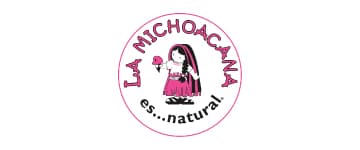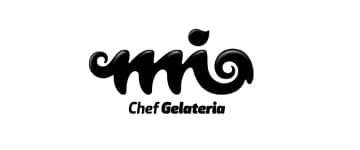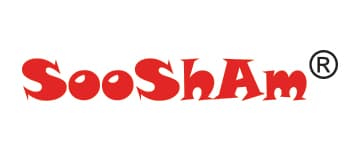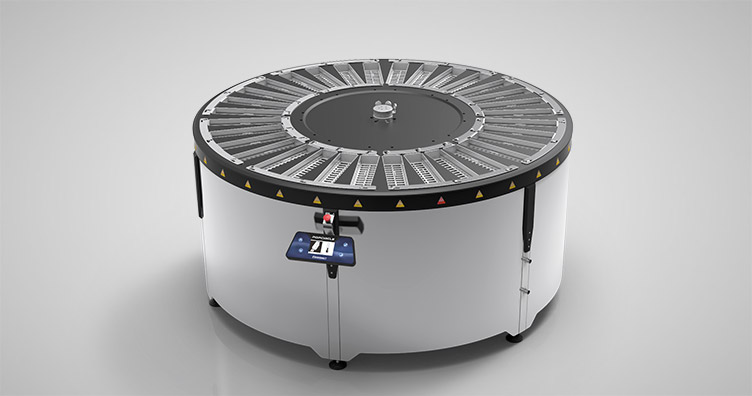
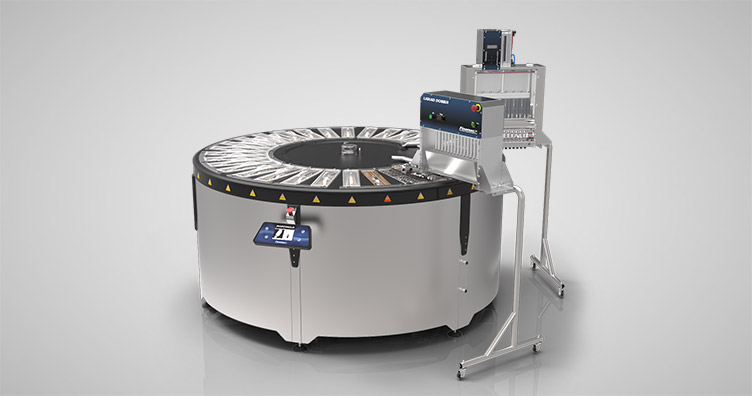
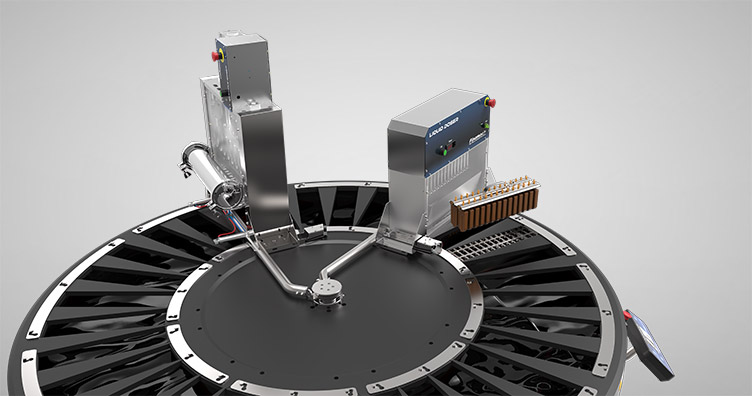
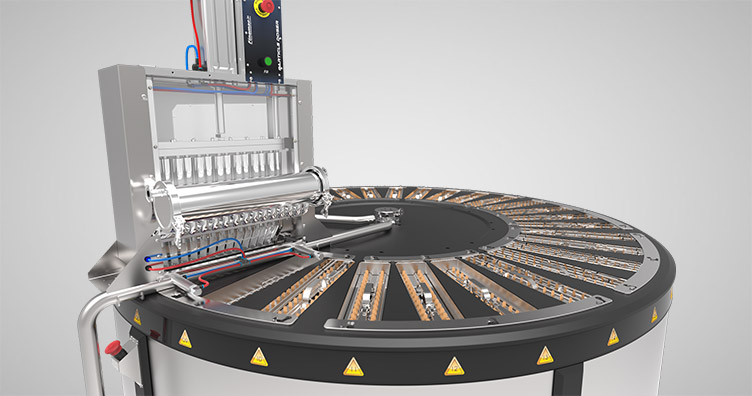
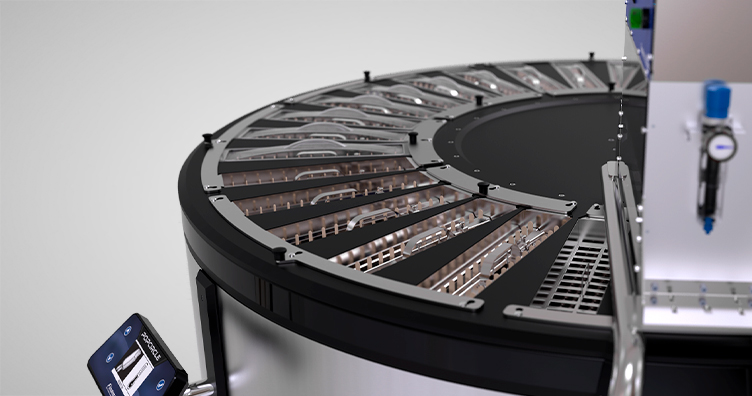
This equipment will be available for sale in 2025.
* Machine available only in 60hz at the moment
** This model just work with our molds. Check the models available.
This is the first equipment in the world that produces industrial ice pops using conventional molds arranged in a circle.
It is also the first in the category to have an automatic ice pop unmolding station.
The PopCircle machine is the closest you get to a 100% automated pop making machine, with very little investment and similar in price to the partially automated machines available on the current market.
Machines for ice pop production are divided into three categories:
1. Artisanal: for production up to 1000 ice pops/hour, with manual operation and low investment. See example: Finamac's Robopop.
2. Semi industrial: from 2000 to 6000/hour, with partially automated operation and medium investment. See example: Finamac's PopLine.
3. Industrial: above 8000/hour, with 100% automated operation and high investment. See example: Finamac's Titan.
The PopCircle machine serves the semi-industrial ice pop production market and accommodates conventional molds on a circular table, producing up to 4500 ice pops per hour. This is a significant development of the linear machines already manufactured by Finamac™, whose molds are accommodated linearly, as in the Finamac™ PopLine.
The ice pop molds used in the machines of the artisanal and semi-industrial categories are commercial products, ranging in different sizes and formats, standardized by its manufacturers. Its main characteristics are the low cost and the possibility of use in several machines.
Molds of the industrial category, in turn, are expensive and can be used only with the equipment for which they are manufactured.
The circular configuration of the molds, coupled with the circulation system of freezing fluid, makes the PopCircle use less amounts of molds than the conventional linear machines, but produces more ice pops per hour.
Each mold is equipped with a clear non-toxic plastic lid to ensure that no impurities enter the ice pops.
The table rotates intermittently along with the molds over a tank filled with freezing fluid so as to bathe all the molds and provide freezing of the ice pop mixture contained therein.
Such a table rotates 12 degrees every 20 seconds on average by positioning one mold at a time underneath automated devices for dosing the mixture to be frozen. These devices are fixed at predetermined points around the equipment. Unlike conventional machines, PopCircle does not use compressed air to move the molds.
Simple gravity dosers are used for liquids of water-based ice pops (lemon, grape etc.) or milk (vanilla, strawberry etc.). Volumetric dosers are used for fillings such as caramel, chocolate pastes and thick substances. Particulate dosers are used for small pieces (1/8” maximum) of nuts, dried fruit etc., for a more elaborate ice pop.
The wooden sticks are automatically aligned by the Finamac™ Aligner equipment and subsequently inserted into the ice pops molds in groups of 28 sticks, manually, after the dosing of the molds.
The dosing units are supported on the ground with casters and not to the machine structure as in conventional equipment. This means that it is very easy to prepare the machine to dose 3 flavors by placing 3 liquid dispensers in sequence, or inserting fillings by placing a filling doser after the liquid dispensers and so forth, by simply moving the doser to the desired point.
In conventional equipment it is necessary to disassemble these units to relocate them in another position, a laborious and time consuming operation due to the weight of these heavy devices.
As the table rotates, the ice pops are gradually frozen until the 1st. mold dosed reaches two stations before a new dosing. At that point, an automatic unmolding device, located underneath that mold, comes into play.
The unmolding is done by circulating hot fluid around the mold for a few seconds, in order to detach the ice pops from its walls and facilitate their extraction. The extraction of ice pops is done just after the unmolding, manually, leaving 28 ice pops completed with each stop of the table. This unmolding system is an innovation created by Finamac™.
After unmolding and extracting the ice pops, the mold remains in the table and is rotated two more times at 12 degrees until it reaches the point of a new dosage and so on.
In conventional linear machines each mold needs to be withdrawn from the freezing tank to be immersed in a hot water tank, out of the equipment, causing splashes of freezing fluid throughout the establishment. These spills wet the floor and waste fluid, as well as increasingly insert water into the freezing tank, requiring the fluid to be completely exchanged in short periods of use by the drop in efficiency.
Made of thermo-insulating material, it avoids the formation of water droplets by condensation and seals the molds in a way so as not to allow drops of the freezing fluid to splash on the ice pops, a very common occurrence in conventional machines in which the molds are arranged linearly and without protection between them.
In addition, the table also dramatically reduces the loss of freezing fluid by evaporation, as well as the entrance of impurities.
Each mold is accommodated in a precise cutout made on the circular table, so that there is no physical contact between one mold and another. In conventional linear machines one mold pushes the other and there is direct contact between them, causing "denting” and shortening its life.
The independent accommodation of each mold allows the replacement of a single or multiple molds, at any time of production, for maintenance, exchange of ice pop type or cleaning.
It allows to replace the models of the molds quickly and simply, unlike the tables used in industrial machines that have molds welded in it and require many hours for disassembly and assembly in the machine.
The circular tables used in industrial machines do not have any thermal insulation and suffer from the formation of water on their surface, which inevitably ends up entering the ice pops.
Made of composite materials, in one piece, it has high thermal insulation capacity and unparalleled mechanical resistance preventing any type of corrosion. It is very light when compared to conventional tanks made of stainless steel.
It has an internal reservoir that provides constant leveling of the fluid, preventing the operator from worrying about checking and regulating this level constantly, manually, very common in conventional linear equipment.
The exchange of molds to produce ice pops of other shapes, with more or less volume of the dosed mixture, also does not require the operator to check the level of freezing fluid, as this is automatically regulated according to the new volume of ice pops inserted in the process.
The level of freezing fluid is kept constant even when some molds are removed from the equipment for some reason, avoiding production delays. In conventional machines the removal of molds causes the fluid level to drop and this causes delays in production because the ice pops are not completely bathed.
Its circular shape has recesses and rounded corners scientifically studied so that the freezing fluid is efficiently sprayed under the molds in a uniform way, a very important requirement for producing ice pops with fillings inside. Such level of freezing fluid circulation efficiency cannot be achieved in conventional tanks made of welded stainless steel sheets, very common in linear machines.
The recesses of the tank and rounded corners result in a decrease in the amount of freezing fluid needed, an economic value point that cannot be achieved in "square" tanks made of stainless steel welded sheets.
To avoid melting ice pops subjected to hot chocolate coatings or syrup fillings it may require freezing up to -22F/-30°C.
Aerated ice pops also need an extra low temperature to avoid air bubbles from rising to the top. The same happens with ice pops that have solid particles in their composition, that tend to decant if the freezing is not done quickly.
In order to reach these temperatures a special fluid is used for both freezing and detaching ice pops from their molds.
The most common fluids used by semi industrial ice pop machines work efficiently up to -4F/-20°C maximum. Industrial machines use a fluid which can work up to -31F/-35°C, but it is very corrosive and can damage the machine and molds.
This special fluid used in PopCircle can work at very low temperatures with higher performance than conventional fluids.
The result is a much faster, cleaner and more efficient ice pop production.
Unlike conventional equipment, PopCircle does not use commercial electronic controllers, which are generally adapted for use. The electronic control unit is 100% designed by Finamac™ to be used exclusively in PopCircle, with maximum efficiency and without adaptations.
This electronic control panel is also equipped with touch panel in a completely washable tempered glass and monitors the following functions:
Circular table speed, depending on desired production and freezing temperature.
Sensors detect possible failures in the dosage processes, insertion of wooden sticks and extraction of ice pops, analyzing the situation and making the best decision to the next step in order to avoid that the equipment is paralyzed if the fault is minor.
Measurement of cold (freezing of ice pops) and hot (for unmolding) fluid levels, as well as the operation of the pumps circulating them, depending on possible variations in fluid densities or presence of impurities in the circuit.
Capturing data from the refrigeration system to withstand liquid strokes, possible oil shortage, abnormal variations in working pressures and other possible occurrences in order to increase the life of the refrigeration compressor, the main component of the system.
Complete control over preventive and corrective maintenance operations, with detailed indication of any faults and suggested actions to remedy them.
All the technological innovation of this project made Siemens use PopCircle as an example to demonstrate the new functionalities of its 3D engineering software: POPCIRCLE AT SOLID EDGE 2021 PRESENTATION
Water condensation equipment: requires a cooling tower.
When purchasing our products, we guarantee excellence in quality and support.
We provide after sales with qualified and dedicated specialists.
Small and medium sized ice pop industries that seek greater automation of their manufacturing processes.
Wooden stick aligner
Pop mold doser for liquids
Fruit Mix
Mixer 100
Super C
Pasteurizers
Much lower investment than 100% automated industrial equipment.
It can operate with very low initial investment, without automatic dosing and wooden stick aligner units, for example, coupling these devices as needed, up to the automated ice pops packaging.
It reduces the number of people involved in the ice pop manufacturing process. The electronic control unit of the equipment performs several functions of monitoring and decision making, requiring little intervention of the operator.
Less space occupied (only 2.2m / 86.61in in diameter) and better use of it, since the access to any point of the equipment is always circular.
Lower energy cost per ice pop produced due to the low thermal loss of the tank, the efficiency of the refrigeration system and distribution of the freezing fluid under the molds.
Great versatility of installation and operation, since both PopCircle and its dosing units are supported on casters, making much easier the eventual changes of the factory lay out. Conventional machines are usually fixed to the floor and do not offer this facility.
Easy transportation and handling: very low weight due to the use of composite materials in its construction.
Easy to maintain: the stainless steel lower structure is put together with screws and not welded as in conventional machines, allowing access to all components of the equipment.
Easy to install: refrigeration system, devices for turning the table and unmolding ice pops are placed inside the equipment, requiring only an external cooling tower. Conventional machines usually have units external to the equipment, which makes it difficult to install.
Resale value guaranteed because it is compact equipment of high production and equipped with state-of-the-art technology with all control systems included. It is a module of production of ice pops of high efficiency and low cost when compared to conventional industrial equipment.
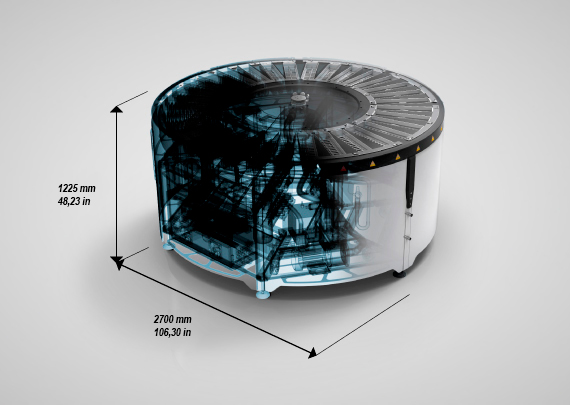
FinamacTM is the number 1 choice of pop stores in the USA, also providing technological solutions for ice cream, ice pops and frozen desserts, exporting machinery worldwide to more than 100 countries.







